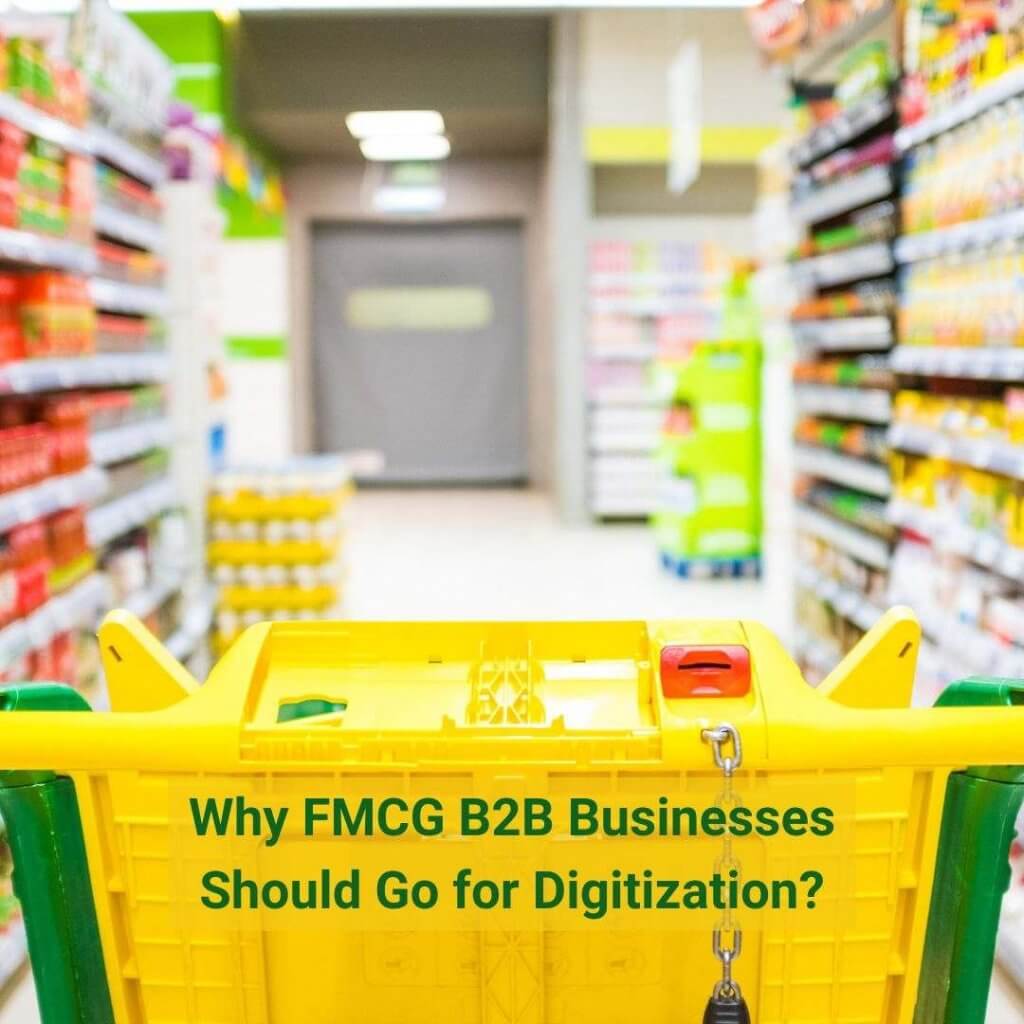
Expand Your B2B Business Using IBM I and Magento
While B2C eCommerce is one of the fastest-growing sectors of the economy, B2B eCommerce offers even more intriguing opportunities. A reliable & user-friendly eCommerce site is much more important than ever.
The importance of an omnichannel B2B eCommerce strategy is underscored in Forrester’s report, “What It Takes to Be a Leader in B2B eCommerce.” When polling B2B executives, Forrester revealed that digital channels remain crucial to sales performance. Customers continue to expect businesses to communicate to them on their terms, and eCommerce is an excellent way to fulfil that demand.
According to the Forrester analysis, “enhanced customer experience has led to more engaged and loyal customers, which supports stronger revenue growth & financial success.”
So, how do you begin with B2B eCommerce? With critical business data maintained on your IBM I, your company is well-positioned to interface with a trustworthy, adaptable, and all-encompassing eCommerce platform such as Magento Commerce. Nevertheless, before implementing technology, your company should be prepared for successful B2B eCommerce implementation with a dedicated team and plan.
By the Numbers: Why Do You Need B2B eCommerce?
- Order capture via paper-based channels is 250 percent more costly than digital channels.
- Business buyers do not contact suppliers until the purchasing process is 57 percent complete.
- 63 percent of B2B customers conduct at least half of their job purchases online.
- 61 percent of B2B customers conduct work-purchase research on their smartphones.
- 53% of B2B purchasers make at least half of their work purchases online.
Grow Your B2B Business with IBM i and Magento Commerce
While B2C eCommerce is among the fastest expanding areas in the economy, and even more exciting possibility exists in B2B eCommerce. A trustworthy and user-friendly eCommerce website is more vital than ever.
The necessity of such an omnichannel B2B commerce approach is highlighted in Forrester’s research, “What It Needs to Become a Leader in B2B eCommerce.” Forrester discovered that digital channels remain critical to sales performance when polling B2B executives. Customers continue to want companies to interact with them on their terms, & eCommerce is a fantastic method to achieve that desire.
“Improved customer experience leads to more engaged and committed customers, which supports higher revenue growth and financial success,” according to the Forrester report.
So, how can you get started with B2B eCommerce? With key business data saved on your IBM I your firm is well-positioned to integrate with a dependable, versatile, and comprehensive eCommerce platform like Magento Commerce. However, before using technology, your firm must be prepared for effective B2B eCommerce adoption with a committed team and plan.
What Does It Take to Be a B2B eCommerce Leader?
“Successful B2B businesses win, service, and keep clients using both online and offline channels.”
However, digital is becoming increasingly crucial in assisting B2B enterprises in achieving high-level business results beyond revenue; many consider B2B digital commerce as a major differentiation from rivals.”
-Forrester Consulting.
The Details
- Integrated Magento Commerce & IBM I utilizing IBM WebSphere MQ & our tried and trusted RPG/XML procedures.
- Ensured that all online orders could be completed by IBM I.
- Developed a unique and targeted approach to advertisements and marketing to increase conversions.
Project Advantages
- Transactions increased by 75%.
- Revenue increased by 70%.
- Unique purchasers increased by 65%.
- Greater up-sell and cross-sell capabilities, improved SEO and interactive marketing, expanded shopping tools, and increased up-sell and cross-sell capabilities.
- Better internal control and the ability to administer the website without the need for development.
Gaining Support and Developing a Strategy
A successful B2B firm, according to Forrester, must have “developed committed eCommerce leadership, resources, & cross-functional strategy to varying degrees.”
Having these specialized elements in place can result in a more simplified route to buy, increased customer happiness and retention, improved competitive advantage, and income generation.
Create an eCommerce Strategy
Before you begin a Magento eCommerce and IBM I integration, you should ask yourself a few questions:
What is the purpose of the website?
- Increase your revenue.
- Reduce Costs and Increase Customer Satisfaction.
Is this project compatible with the company's purpose and vision statements?
Can you calculate success?
Proper planning ahead of time helps everyone in the business to know the project scope, when every milestone will be accomplished, and, most importantly, why the project has been undertaken in the first place. This lays the groundwork and provides alignment inside the organization, ensuring that everyone is working toward the same goal.
– Peter Sheldon, Senior Director of Commerce Strategy at Adobe, in Volume One of the Journal of Digital Commerce.
Engage the Sales Team
In a B2B context, the sales staff may be resentful of a new eCommerce site, considering it as both competition and then a distraction. Given this, bringing on the sales staff early will be crucial to the growth of your website.
Ensure that the sales staff knows the purpose of the internet site in the organization and how they may use it to their advantage. An eCommerce site may be a significant tool in your sales team’s armoury for meeting your client’s demands successfully and efficiently.
In our expertise, once the sales staff sees how the site connects with corporate goals and how the site will benefit them directly, they might very well embrace the project and also the new site.
Develop a Project Champion
An eCommerce project, particularly in a B2B context, will impact practically every aspect of your business, including marketing and sales, operations, finance, and, most importantly, IT. Within your firm, there has to be a champion for this attempt, someone who will assist to carry the project to completion & ensure that it receives the attention it needs after that.
“There can only be an only top priority,” our staff often says. If no one on your team has the site as their top priority, then no one has the site as their top priority. Your B2B eCommerce website could fail if you do not pay continual attention and effort to it.
The Ideal Candidate
Project Champion
Description of the job:
We are looking for an effective leader who can build relationships across the business. To guarantee the effectiveness of a B2B eCommerce endeavour, you must be a skilled negotiator who can attract organizational support.
Experience Required:
Conventional sales tactics :
- Digital technologies
- Social marketing strategies
- Leveraging such talents in a business-to-business environment
Using a Proven Integration Method
In many experiences of IBM I integration experience, we’ve found three elements that assist every integration project, regardless matter the company or environment, succeed: specifying data organization, putting business logic in which it belongs, and sticking to an established integration process.
Data: The Only True Source
Both IBM I & Magento Ecommerce are capable of holding the data required for this integration, therefore which system should have complete ownership of the commerce information? We discovered that maintaining data stored in the most prevalent answer is IBM I particularly when it comes to inventory & availability data.
This becomes complicated when it comes to transaction time.
- When do the inventories in IBM I decrement?
- How promptly is Magento data passed or accessed?
These are important factors to consider while developing the integration. Another critical issue is whether Magento Commerce checks inventory availability in real-time,’ or if a batch update uploads goods to the site. If inventory balances are pushed regularly, the next question is how frequently.
We understand that this is a lot to think about, but identifying your data organization plan is critical. It will aid in determining how things will play out and how frequently information will be updated. Keep in mind that preparing your material again for the web is a continual effort. After you release your B2B eCommerce site, you will almost certainly continue to develop it.
The Importance of Data Mapping with Batch Bicycles
Project Advantages:
- Development of a new income stream
- Clean integration with current IBM i-based ERP & third-party modules
- Improved data exchange between systems
- Improved customer experience
Batch Bicycles, a new brand launched under the umbrella of United Wheels, has a distinct vision for its eCommerce site. Rather than selling bikes directly to clients through the web channel, Batch would let users choose and purchase their bikes from the eCommerce website, then grab their assembled bikes from their local independent bike store. They needed sophisticated connectivity across our newest Magento Commerce site and their previous IBM i-based ERP to achieve that goal.
This project’s unusual sales process necessitated a detailed examination of the data involved. We used data mapping to identify integration points and establish what information needed to be stored where. We were able to develop accurate and adaptable connectivity among Magento Commerce and also the IBM i-based ERP by outlining those objectives from the outset.
Keep the Business Logic Where It Belongs
Consider the business logic necessary to handle an eCommerce order after determining if Magento eCommerce or IBM I own each piece of data. eCommerce systems typically incorporate functionality that is mirrored in ERP, including item pricing, taxation, and order processing. Consider keeping a company’s operations inside the system that is most suited for performing that function when examining these redundancies.
Pricing Engine:
The pricing algorithms in most strong ERP and eCommerce systems are quite versatile. Magento Commerce, on the other hand, has sophisticated promotion and discount modules. Duplicating the IBM I pricing engine further into the Magento system is a difficult process that is typically not advised.
Tax Calculations:
In most cases, you may preserve the IBM I tax calculation function because this is where order processing takes place.
However, if orders placed in IBM I are not taxed but orders in Magento are, it makes more sense to put the tax calculation code in Magento Commerce.
Every project is unique, and also the project team should examine the business logic to identify which system best supports the functionality.
Use a Proven Integration Methodology: Ten+ Points of Integration
When determining which approach to utilize, you must consider both the initial programming requirements and continuing maintenance. For success, our team frequently relies on our Ten+ Points of Integration method.
Our basic integration approach considers 10 various integration points, as well as the associated business logic and procedures. Each project’s goals decide whether an integration point is required and how it is used within the entire project. Typically, 4 to 6 integration points are used in a project, however, we have seen projects only with one or two, as well as ones with all 10.
THESE POINTS OF INTEGRATION INCLUDE:
- Catalog
- Customer
- Inventory
- Price
- Tax
- Shipping
- Payments
- Order creation
- Order shipment
- Order update
- Order History
- Invoices
Integration Tools
One big issue we’ve heard from customers is that the critical data saved on their IBM I is incompatible with just an eCommerce platform. However, transferring information across IBM I & Magento Commerce is simple; all you need is the correct tool.
Among the alternatives are:
• Web Services
Because there is no need to purchase new software, Web Services is an excellent choice. IBM I provides the ability to construct and host web services within the native system.
• IBM WebSphere MQ
WebSphere MQ is a reasonably affordable solution that adds enormous value to the project and team. This software package, which is installed on IBM I &, optionally, on an external machine, allows for secure and safe message transport between IBM I & Magento Commerce.
• Mulesoft:
Mule ESB and/or its larger Anypoint platform, we’ve discovered, is the ideal solution for more complicated projects since it functions as just a middleware between the two platforms. At its most basic, this utility handles payments between IBM I and Magento Commerce. It is more sturdy and has more functionality than the other alternatives.
Watson’s Leverages Middleware for IBM i Integration Success
Watson’s, a recreation & outdoor goods business, understood it would be a difficult challenge to integrate Magento Commerce with its IBM i-based, proprietary RPG ERP. Our team has extensive experience connecting proprietary Erp software with Magento Commerce, so we knew their third part middleware would be a significant resource.
Watson’s clients can now not only purchase online but also examine a full omnichannel order history, thanks to the use of middleware to interact in order between Magento Commerce & their previous RPG-based ERP. Because of the improved order integration process, an item may now be chosen, packed, and dispatched from the warehouses on the same day it was made online.
Integration Points:
- Catalog data was transferred to the ERP and is now flowing to Magento Commerce, allowing information to be posted online more quickly.
- Product data, price data, order status, & inventory feed allow customers to know where their order is in the process. That is previous online or in-store transactions, as well as precise in-store inventory.
Working with the database structure was difficult, as it is with any bespoke RPG ERP. However, our staff has extensive expertise with IBM I bespoke ERPs, and difficult integrations, resulting in a successful outcome.
This project demonstrated the necessary give and take for just an integration to work.
While the previous Watson’s personnel lacked integration experience, they were well knowledgeable about their system’s structure and business procedures. Our team relied on their business knowledge while providing our integration experience. This IBM I & Magento Commerce connection would not have been possible without that collaboration.
Site Security and Go-Live
After all of your hard work, it’s critical to maintain your new site secure. One important approach to do this is to adhere to IBM I security best practices.
Security Considerations
In general, IBM I security begins with the user. You may begin your security strategy by selecting the elements that will have the most impact with the least amount of work, such as:
Personal conduct and passwords: ensure that team members are not using weak passwords, reusing passwords, or reading phishing emails.
- Administrator rights: IBM I has 8 administrator-level powers that should be used sparingly and closely managed.
The following are important questions to ask regarding your IBM I security plans: • Does your company get a security policy? Is it evaluated and updated every year?
The following are important questions to ask regarding your IBM I security plans:
- Do you have and manage reaction and recovery plans? Is a risk management strategy in the works?
- Do all workers have their user profiles? Employees, do you reset your passwords at least 2 times a year?
- Have user roles been established via the use of groups or authorization records? When and when does adopted authority come into play?
- Is the operating system on the System I supported for at minimum the next 2 years?
- Do you also have a formal offshore data rotation procedure in place? Did you test backup data regularly?
It’s okay if you’re feeling overwhelmed by these inquiries. Taking a single small step is still preferable to taking no step at all.
Customer Experience and Go-Live
You’ve finally launched your B2B eCommerce website following navigating an often integration seas. Congratulations!
But the job isn’t done yet.
You may use Magento Commerce’s numerous versatile capabilities for eCommerce success that now your IBM I is linked with it. By combining the capabilities of your IBM I with Magento, you now can leverage all that backend customer data to fuel Magento’s various marketing options, providing a better experience for the customer.
What Benefits Does Personalization Bring to the Shopping Experience?
Personalization is one of the finest methods to improve customer experience, which has been identified as a competitive strain pushing eCommerce. Customers nowadays want websites to recognize who they really are, what they like & hate, and even predict their needs and desires. Tracking client behaviour, historical purchases, and conversion rates may help develop an eCommerce experience that’s also tailored to each consumer.
You can target your particular consumers more accurately if you’ve got a better grasp of their wants and goals. Customers are more likely to stay on your site and browse if they find something they like, and tailored suggestions on a page convert 65 percent more than a generic page.
Rule-Based Product Relations
Magento Commerce supports cross-sell, upsell, & related product features using rule-based product relationships. A product’s rules are defined so if it fits certain conditions, a particular matching product is presented. These criteria might be based on a variety of factors, including price, manufacturer, consumer group, and special product features.
“When developing a B2B site, keep in mind that the individual buying B2B during the workday is also browsing B2C websites in the evening; why do the experiences be different?”
– Gian Genovesi, Magento Delivery Lead, Briteskies
Customer Segmentation
Depending on the eCommerce software, these tools may be referred to by different names. Whatever they’re termed, these technologies eventually enable the formation of client groups depending on their actions. These consumer groups may then be utilized in marketing efforts, email campaigns, tailored content, special pricing, and promotions.
Any online B2B marketer may use these techniques to offer consumers specialized, targeted information including pricing that makes them feel as if the site was made just for them.
The final stage in establishing the B2B eCommerce website of your desire is to fully utilize Magento Commerce’s marketing features.
Giving your customers a fully informed, neatly connected, and intuitive buying experience is well worth the effort of connecting your IBM I using Magento Commerce.
Did You Even know?
One-third of survey respondents indicated they want to make data useful to sell to and assist their clients throughout the B2B buyer’s journey.
(From eMarketer) You’re slipping behind if you’re not doing the same.
Make the most of Magento Commerce's capabilities with a B2B integration project.
We’ve been smoothly integrating Magento Commerce, part of Adobe Commerce Cloud, with ERPs like IBM I and third-party technologies for years to streamline your business processes and improve your customers’ shopping experience.
Do you want to know more? Visit briteskies.com/magento-ecommerce-integration
About Briteskies
Briteskies has established our goal to help you to work smarter for the past 2 decades.
Briteskies, as a commerce consulting business, can help you design, develop, and implement your commerce implementation, as well as give extra help when you are short-staffed.
Your shop and your ERP system From e-commerce issues to ERP adaptations.
We support the power of their big ideas by assisting you in working more strategically, and more effectively.
Intuitively and more effectively.
We are happy to be a JD Edwards Gold Partner and a Magento Silver Solution Partner.
IBM Premier Business Partner with experience in both World & EnterpriseOne.
Briteskies may be found online at briteskies.com.
About Magento Commerce
Magento Commerce, a component of Adobe Experience Cloud, is the top commerce solution for merchants and brands in both the B2C and B2B industries, and it was recently designated a leader in the Gartner Magic Quadrant for Digital Commerce. Magento Commerce offers a robust array of cloud-based omnichannel solutions that enable retailers to seamlessly connect digital and physical purchasing experiences. Magento is the number one source for the Internet Retailer Top 1000, B2B 300, and Top 500 Guides for Europe and Latin America. Magento is backed by a huge global network of solution and technology partners, a vibrant global developer community, and the world’s largest eCommerce marketplace for extension downloads on the Magento Marketplace. More information is available at magento.com.
Why Ceymox Technologies?
At Ceymox Technologies, we are having expertise in developing e-commerce stores from scratch using Magento Commerce. Our certified Magento developers can develop highly functioning e-commerce stores with advanced features and functionalities. Let us know your requirements.
 Hubspot SEO Certified |  Hubspot SEO II Certified |  Google Ads Search Certified |  Google Analytics Certified |
Sreehari N Kartha is a skilled Digital Marketing Analyst at Ceymox, certified in SEO. His expertise encompasses a wide range of digital marketing strategies, including managing advertising campaigns on platforms like Google Ads, Facebook Ads, Instagram Ads, WhatsApp Ads, and LinkedIn Ads. With a strong foundation in SEO and SMM, Sreehari is adept at optimizing online visibility, driving engagement, and generating qualified leads and conversions. His passion for emerging technologies, such as Crypto, NFTs, and Web3, further complements his skillset, enabling him to navigate the dynamic digital landscape.
View All Articles


